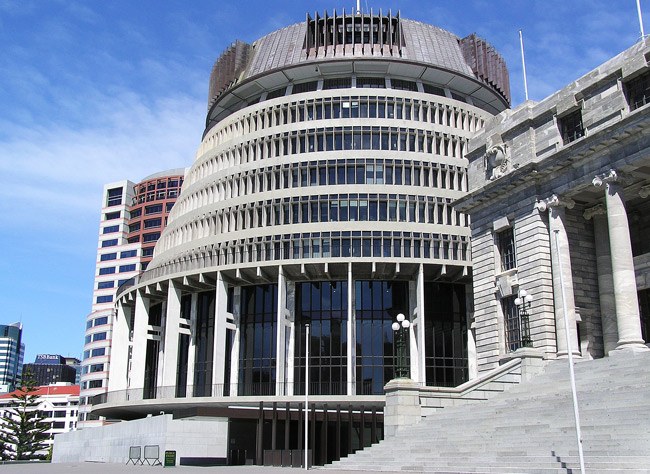The 2017 general election is likely to be remembered for two things: the extraordinary rise of Jacinda Ardern from deputy Labour Party leader to Prime Minister, and as the first MMP election when the largest party did not form the government. In an opinion piece written for the Otago Bulletin Board, the Head of Otago's Department of Politics Professor Janine Hayward elaborates.

A new government was sworn into office today.

Professor Janine Hayward.
The Labour-New Zealand First-Green party governing arrangement announced last week is similar in principle to previous MMP governments. Labour will form a coalition with New Zealand First, and have a confidence and supply arrangement with the Green Party. The difference between coalition and confidence and supply arrangments relates to who is inside and outside Cabinet, the powerhouse of New Zealand politics. New Zealand First's coalition agreement gives the party ministers inside Cabinet who will have access to decision-making, but who (in the absence of an 'agree to disagree clause') will be bound by the strong convention of collective Cabinet responsibility. This means New Zealand First will publicly support the government's policy direction, regardless of debates that occur inside Cabinet. On the other hand, the Green Party's confidence and supply agreement will require the Green party to support the government on important bills such as the budget, but Green party ministers outside Cabinet will not be required to agree with the government's broad policy direction.
While the form of government is familiar, for the first time under MMP, the largest party in Parliament has not formed the government. This has provoked debates about whether the outcome is 'fair' because National won the most seats, but could not form a government. MMP (like FPP before it) elects Parliaments, not governments. Regardless of which party has the most MPs elected to Parliament, a majority of elected MPs needs to show they have the confidence of the House to form (or support) a government. It is unusual for the largest party not to form the government, even by international standards, but it is simply not possible for even the largest party to govern under any electoral system if it does not have the confidence of the House.

New Zealand's new Prime Minister, Jacinda Ardern, on the campaign trail last month.
In addition, New Zealand First was said to be 'holding the country to ransom' while it decided who would be the next Prime Minister. (And the gendered language of 'King-maker' persisted even after Arden's promotion). There were complaints that this was undemocratic, because a party with 7 per cent support was determining the new government. This made for exciting headlines, but overstates the influence of minor parties in coalition negotiations. The election results tell us that New Zealand voters are very closely balanced between the centre-left (Labour/Greens) and centre-right (National), but neither the centre-right nor the centre-left is the majority view. In both cases, the centre vote (New Zealand First) needs to be taken into account for either the centre-left or centre-right to represent a majority in Parliament.
Moreover, whichever way New Zealand First went, their influence pulls policy in the direction of MPs elected on the other side of the House which again reflects the balance of views amongst elected MPs. The policy announcements emerging from the Labour-New Zealand First coalition negotiations show that New Zealand First has not received a ransom – it has influenced some aspects of policy in ways that have the support of a majority of MPs.
"The policy announcements emerging from the Labour-New Zealand First coalition negotiations show that New Zealand First has not received a ransom – it has influenced some aspects of policy in ways that have the support of a majority of MPs."
Beyond the drama of government formation, the 2017 general election should also be remembered for the increase in voter turnout. Very soon after the election result, turnout was announced as only slightly up on the 2014 turnout of 77.89 per cent. The anticipated 'youthquake' was dimissed as a non-event and attention moved on. In fact, the increase in turnout was significant. The final figure for turnout is 79.75 per cent, but even this is not the full story. That figure reflects the number of registered voters who voted. But in 2017, the number of people registered to vote increased by over 157,000 voters (an increase of over 4 per cent from 2014). The number of people who voted increased by over 185,000. So, turnout compared to eligible voters (as opposed to registered voters) increased from 74 per cent in 2014 to 77.7 per cent in 2017. Within the context of a decline in voter turnout over several decades, this is a significant achievement and one we ought to celebrate and build on in 2020.
Closer to home, a youthquake was also detectable. In Dunedin North, the electorate with a large student population, an additional 2452 voters registered to vote in 2017 than had registered in 2014 (or 4.4 per cent of the eligible population) and 2045 more voters voted in 2017 than in 2014 (or 3.7 per cent of the eligible population). More importantly, newly registered voters in 2017 were disporportionately 18- to 24-year-olds which is a great achievement, given how unlikely that age-group is to engage with voting.
In terms of what Dunedin North voted for, 66.5 per cent of voters in the electorate gave their party vote to either Labour, the Green party or New Zealand First. Labour had campaigned on increasing living costs support for students, restoring postgraduate student allowances, and introducing one year free tertiary education in 2018, extended to three years by 2024. Exactly which of these policies will be implemented once the new government is in place remains to be seen.
